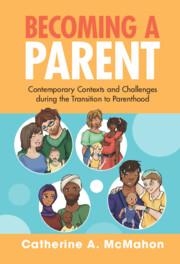Book contents
- Becoming a Parent
- Becoming a Parent
- Copyright page
- Dedication
- Contents
- Preface
- Acknowledgements
- Permissions
- Chapter 1 Contemplating Parenthood
- Chapter 2 Reproductive Technologies
- Chapter 3 Becoming a Mother
- Chapter 4 Becoming a Father
- Chapter 5 High Stakes Pregnancies
- Chapter 6 Alternative Pathways
- Chapter 7 Childbirth
- Chapter 8 The Fourth Trimester
- Chapter 9 The Way Forward
- References
- Index
Chapter 6 - Alternative Pathways
Becoming a Parent through Reproductive Donation or Adoption
Published online by Cambridge University Press: 18 November 2022
- Becoming a Parent
- Becoming a Parent
- Copyright page
- Dedication
- Contents
- Preface
- Acknowledgements
- Permissions
- Chapter 1 Contemplating Parenthood
- Chapter 2 Reproductive Technologies
- Chapter 3 Becoming a Mother
- Chapter 4 Becoming a Father
- Chapter 5 High Stakes Pregnancies
- Chapter 6 Alternative Pathways
- Chapter 7 Childbirth
- Chapter 8 The Fourth Trimester
- Chapter 9 The Way Forward
- References
- Index
Summary
This chapter considers the more complicated process of becoming a parent when one or both parents is not genetically related to the child, and there is a third party (donor, relinquishing parent, or surrogate) involved. The chapter first sets out the key psychological and social challenges that are shared across all modes of non-biological parenthood, and then examines theory and research evidence on the transition to parenthood for heterosexual couples conceiving with donated sperm, eggs, or embryos, women who choose to embark on parenthood alone, with the assistance of a sperm donor, lesbian couples, gay couples, and those who adopt a child.
Keywords
- Type
- Chapter
- Information
- Becoming a ParentContemporary Contexts and Challenges during the Transition to Parenthood, pp. 131 - 167Publisher: Cambridge University PressPrint publication year: 2022



